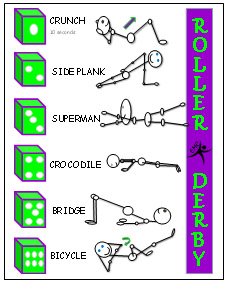Roller Derby
Quick LinksInformation: Activity Description (PDF) Resources: Roller Derby Blank Cards (PDF) Roller Derby Core Training Cards (PDF) Roller Derby Dynamic Flexibility Cards (PDF) Roller Derby Fun Stunts Cards (PDF) Roller Derby Jump Rope Cards (PDF) Roller Derby Medicine Ball Cards (PDF) Roller Derby Muscular Fitness Cards (PDF) Roller Derby Resistance Bands Cards (PDF) Roller Derby Back Bends (PDF) Roller Derby Balance Yoga (PDF) |
Activity Description and Rules:
The objective of this activity is to complete the movement associated with each number on the die at least one time. Create groups with an even number of students in each group (if possible). There are different movement variations for the Roller Derby activity. Groups can choose to complete activities related to dynamic flexibility, muscular fitness, jump rope, yoga, medicine balls, resistance bands, core fitness, stability balls, and fun stunts. Each Roller Derby card has the name and associated picture of six health-related fitness movements.
How to Play:
- Decide the activity time or repetitions for each movement. For example, you can decide to use the die number. This means that if you roll a 4 then you would complete 4 repetitions or 4 seconds of the movement. Or you can set a number. For example, each movement would be 6 seconds or 6 repetitions. This means that it does not matter if you roll a 2 or a 4, you will still complete 6 repetitions of the movement.
- Each group rolls the die which decides which movement the group will perform. Everyone in the group performs the activity together until every number has been performed. For example, if a player rolls a two then every group member completes side planks.
- After the group has completed the movement together, one group member writes the number on the 3x5 card, and then the die is rolled again. Due to chance, the groups could be performing numbers more than once. They should still perform the number even if it has been rolled before. For example, the group’s first roll was a 2 (side planks) and their next roll was a 2 (side planks). The group would still perform the second rolled 2.
- This sequence continues until one group has rolled every number at least once.
Equipment:
- 1 die per team
- Roller Derby station card with activities
- 3x5 card or piece of paper to write and remember numbers completed
Playing Space and Set-Up:
 The teams find an open space in a gymnasium or soccer field.
The teams find an open space in a gymnasium or soccer field.
Game Modifications:
Version #1: All students are performing the same activity. The numbers on the die designates how many times or how many seconds they will perform the movement. For example: the movement could be to perform a crunch. If the team rolls a 4, the entire team would perform 4 crunches. They could be performing a number more than once.
Version #2: The teacher can align Roller Derby with the unit being taught. For example: if you are teaching a badminton unit have the students complete 1 serve if they roll a 1 or 2 serves if they roll a 2. The goal is to complete all numbers on the die at least once.
Version #3: The blank Roller Derby card is used for students to write their own activities in the spaces. Students write what they would like to complete for 1-6. Each group could have and use their own card to perform the activity.
Version #4: In their groups, students write activities 1-6 on the blank Roller Derby card and then the teacher collects the cards and redistributes the cards to the different groups. This way groups do not knows which card they would be getting. The groups then play the activity.
Version #5: The Roller Derby cards can be used as an Instant Activity. An individual student or a pair of students can try to complete each number on the card at least once.
To Print:
There are two Roller Derby cards per PDF page. You will need one card per group. Print the cards on white card stock and laminate. Cut the individual cards before you laminate.